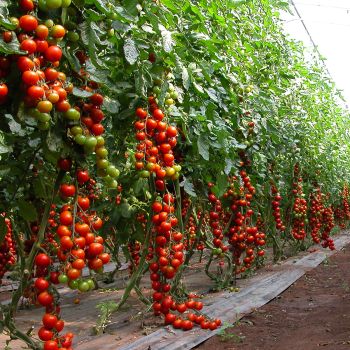THE IMPACT OF BIOSTIMULANTS ON CROP PRODUCTION’S PROFITABILITY
By: Attilio Coletta
Department of Agriculture and Forest Sciences, University of Tuscia, Viterbo, Italy
*Correspondence: coletta@unitus.it

Process innovations’ adoption can affect farmers’ profitability from different sides: an increase of output yields, a better output quality level (and hence selling price), a lower production cost ceteris paribus. Such effects can occur one by one or even jointly.
From an agronomic point of view biostimulants use can represent a process innovation resulting in either a yield increase (being constant the other production factors e.g. fertilisers, water, plant protection products, etc), a higher quality level of the products (e.g. higher marketable quality and nutritional value), or a cost reduction due to a lower inputs’ requirement resulting from a positive effect of biostimulants on inputs’ use efficiency.
Available literature at international level demonstrated several positive effects of biostimulant application on both arable crops and protected cultivations, as shown by the metanalysis carried out by Coletta (2019). Those analysis focused on scientific contributions investigating the effects of a single biostimulant product (excluding experiments where a combination of treatments may result in a difficult identification of a significant effects of a single tested bio-stimulant product), and tried to quantify economic implications for crops cultivated in experimental trials adopting similar agronomic practices used in standard open field cultivation, showing a general positive effect ascribed to the use of biostimulants on yield in several crops.
At present research focus on conventional cultivation, however biostimulants are registered for use in organic farming as well. Organic productions, often affected by nutrients’ deficiencies and/or biotic diseases might have greater benefit from positive effects induced by bio-stimulants products, both on nutrient efficiency and stress resistance to environmental stress, than conventional cultivation processes.
From the point of view of biostimulant use procedures, the majority of products are to be applied by foliar spray, followed by application through drip irrigation, seed treatment and jointly with fertilisers. Different methods, obviously, imply different costs when biostimulants are used in open-field cultivations or under protected cultivation (greenhouses, tunnels, etc.) with different cultivation methods.
Additional cost arising from biostimulant application can be referred to:
- Product cost
- Application cost
- Cost for harvesting and post-harvest management operations
- Cost of additional production coming from biostimulant application
- A higher frequency of biostimulants application
- A better foliar absorption of products, thanks to higher air relative humidity leading to a higher hydration of foliar tissues and wider foliar absorbing area
- A more favourable condition for biomass increases and production
The gross margins calculated based on literature results show positive figures, implying an increase in the production value always higher than the rise in production costs related to biostimulant use (Coletta et al., 2019). For instance, biostimulant application in open field row crops such as durum wheat and rice showed a gross margin increase respectively of 78.0 and 176.2 €/ha. Biostimulant-treated fruit tree crops such as vineyard and apple trees provided a gross margin increase of respectively 69.0 and 2251.8 €/ha. Moreover, gross margin increases of vegetable crops (e.g., tomato, cucumber, zucchini, lettuce, spinach) issued from biostimulant applications ranged from 1967.5 to 11410.7 €/ha in greenhouse conditions and from 1967.5 to 1031.3 to 7612.7 €/ha in open field conditions (Coletta et al., 2019). Some aspects, however, deserve additional efforts in order to confirm the encouraging results that might be positively biased by the experimental conditions (with respect to real farming production conditions), and to the interaction of biostimulants with major production inputs traditionally used (e.g. fertilizers, irrigation water, pesticides, etc.)
For instance, it might be of interest to better quantify the potential benefits of biostimulants related to the optimization of the fertilizer use efficiency and to the reduction of the amount of fertilisers needed, and hence to the production costs. This aspect may be of high interest in order to reduce the environmental impact of fertilizers which can be leached in water bodies when the plant uptake efficiency is low.
Other emerging aspects will require further research efforts before a widespread use of biostimulant products is promoted e.g.: the relationship between doses and effects, the optimal quantities to be used from an economic standpoint (related to different biostimulant products’ price), and the effects of different application procedures.
Finally, additional studies are needed to investigate the potential benefits of biostimulant application on the increase of the gross margin through an improvement of product quality. Better product quality resulting from biostimulant application may increase selling price with an increase of gross margin. For instance, wheat prices depend on the protein content, which has been reported to be improved in durum wheat grains after seed treatment with mycorrhizal fungi (Colla et al., 2015).
Coletta A., (2019), Impatto dei prodotti ad azione biostimolante sulla redditività delle colture, capitolo nel volume Biostimolanti per un’agricoltura sostenibile: Cosa sono, come agiscono e modalità di utilizzo, Edizioni l’Informatore Agrario , ISBN: 9788872203910 http://www.ediagroup.it/ita/libri/scheda.asp?ID=391-0
Colla G., Rouphael Y., Bonini P., Cardarelli M., (2015). Coating seeds with endophytic fungi enhances growth, nutrient uptake, yield and grain quality of winter wheat. International Journal of Plant Production 9 (2): 171-190.



